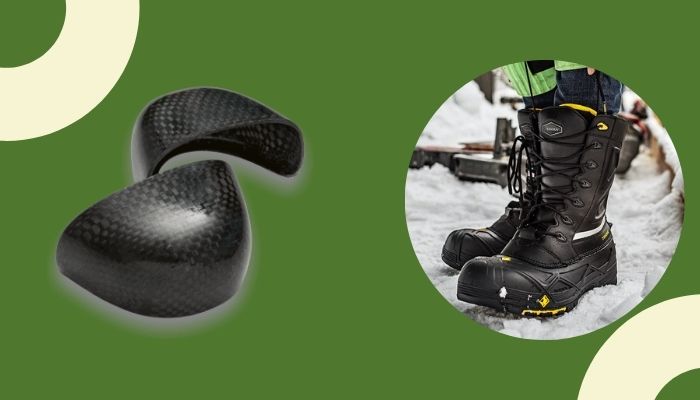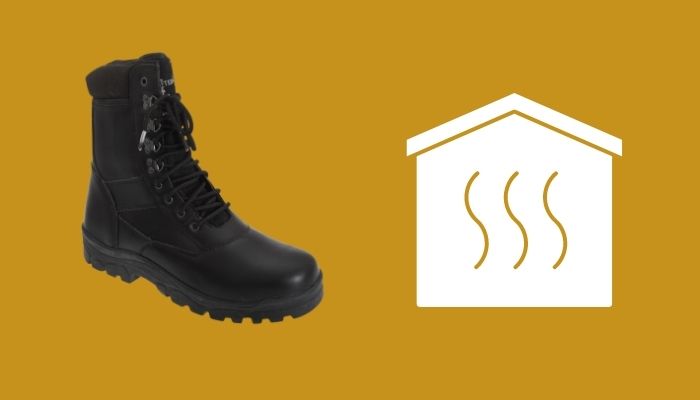Composite toe boots have almost all the features needed to keep your feet safe in a hazardous area, but do they keep your feet safe in the cold?
Hold on! This article has got your answer.
Because composite toe boots are heavy-duty footwear, many of my readers have asked if composite toe boots can endure the fury of minus degree temperatures.

And here I am, armed with all the answers to your most commonly asked questions.
So keep reading to know it all.
Do Composite Toe Boots Get Cold?
No, composite toe boots don’t get cold. Because there is no metal in composite toe boots, there is no conductive element to conduct heat or cold. Although composite toe boots are not perfect winter boots, they keep the feet warm and toasty in cold weather.
Composite toe boots are one of the trusted names when it comes to safety boots, be it to protect your feet from falling heavy objects or keep your feet safe from electric hazards.
Similarly, a few characteristics are added to the composite toe boots, making them usable all year, including the winter.
Unlike steel toe boots, the toe cap of a composite toe boot is not constructed of metal; their toe caps are made of insulating materials that allow the composite toe boots to keep your feet warm.
Your feet will remain warm since the composite toe boots don’t get heat or cold.
Furthermore, composite toe boots do not include any metal; they do not add bulk to the feet and can be easily passed through metal detectors.
Follow our guide on How Much Weight Can Composite Toe Take.
What Is Composite Toe Boot Made Of?
Composite toe boots are safety boots with toes constructed of non-metallic materials such as Kevlar, plastic, fiberglass, and carbon fiber.
Because there is no use of metal in any area of the boots, there is no cold conduction, which keeps the feet warm regardless of how cold the weather is.
Composite toe boots are very lightweight and breathable, so they reduce foot strain, and you can easily walk on them while not interfering with your work time.
Not only are composite toe boots suitable for cold weather, but you can also wear them in hot weather.
Because the boots contain no metal, they cannot conduct heat, keeping your feet cool and fresh. So, rain or shine, you can wear composite toe boots all the time.

Not to add, because of their design and material choices, composite toe boots are exceptionally comfortable to wear.
Their toe box is wider, which lets your toes wiggle. The anti-fatigue technology keeps the feet comfy for a longer time.
The non-metallic objects Kevlar, fiberglass, carbon fiber, and plastic give a softer feel to the feet.
Check out our separate post: Can Composite Toe Boots Be Stretched.
Can You Wear Composite Toe Boots In Winter?
Yes, you can wear composite toe boots in winter. There is no metal in the boots; instead, materials like Kevlar, fiberglass, plastic, and carbon fiber are used in the toe cap, which acts as an insulator. As a result, your feet will stay warm and toasty in the composite toe boots.
Is it just the toe cap that makes composite toe boots suitable for wearing in the cold, or are there other features as well?
Not only the non-conductive toe cap is responsible for keeping your feet warm, but also the Thinsulate insulation protects your feet from the cold.
Also read, Composite Toe Vs Steel Toe Boots.
What is Thinsulate insulation, exactly?
Thinsulate is a synthetic fiber thermal insulation that keeps the boots warm.
In comparison to conventional insulation materials, Thinsulate is meant to have a thinner thickness while doubling the warmth.
The Thinsulate insulation in composite toe boots ensures that your feet stay toasty in the winter and cool in the summer.

You may also like Yeezy 350 Tight On Toes.
Thinsulate composite toe boots come in a variety of ratings, which you can select according to the outside temperature.
Let’s have a look at what they are:
200 Grams: Boots with 200 grams of insulation are ideal for early winter when the weather is mild. The Thinsulate rating of 200g is the most common in boots with high activity levels.
400 Grams: For slightly colder days with moderate physical activity, 400 grams of Thinsulate is sufficient.
600 Grams: 600 grams is recommended on days when it is really cold outside, with temperatures hovering around 10 degrees.
800 Grams: Ideal for days when it’s bitterly chilly outside, and there’s snow and rain. At a 0 to -20 degrees temperature, 800g Thinsulate boots are worn when you can’t feel your feet anymore.
1000 Grams: The 1000g Thinsulate that each boot can have is the highest level of insulation. Your feet will stay toasty in this Thinsulation even if the rest of the world is freezing.
Do check our latest post on What Does Shoe Width Letters Mean.
Why Do Composite Toe Boots Not Get Cold?
Composite toe boots do not conduct cold since the toe caps are not made of metal, and there is Thinsulate insulation to keep the feet warm. Composite boots have a toe cap made of Kevlar, plastic, carbon fiber, and fiberglass that cannot transport cold from the outside to the foot.
Since the toe cap materials have a big hand in making the boots non-conductive, let’s see a brief breakdown of the insulating materials.
Plastic: Plastic is a poor conductor and an excellent insulator, allowing heat to be trapped.
Kevlar: Kevlar is a synthetic fiber that is a form of plastic. And any sort of plastic is poor at transferring heat and cold while being excellent at providing insulation in cold weather.
Fiberglass: Fiberglass is a type of reinforced plastic material made up of glass fibers. Because glass is a poor conductor of heat and cold, it is an excellent insulator for keeping the boots warm.
Carbon fiber: Carbon fiber is a non-conductive material with a substantially lower thermal expansion than steel. As a result, they cannot conduct heat or cold and hence operate as a good insulator.
Do Steel Toe Boots Get Cold?
Yes, steel toe boots get cold in winter. Steel is made up of iron, which is a metal, and metal is an excellent conductor of heat and cold, making steel toe boots extremely frigid. However, you can wear the steel toe boots in mild chilly weather with a pair of thick socks.
Steel toe boots, without a doubt, are durable and provide foot protection in a variety of situations. However, winter is one season when steel toe boots aren’t very useful.
You can wear steel toe boots with thick socks in the winter or snow to keep your feet warm, although this insulation won’t last long.
If you stand in steel toe boots for a long period in the cold weather, the steel in the toe cap will conduct cold so well that your feet may endure frostbite and blisters.
You should go for composite toe boots in the winter because they are fantastic insulators and keep your feet warm and crisp.
Last Few Words
Composite toe boots are not only excellent for keeping your feet safe, but they are also a great choice for both summer and winter wear.
You won’t have sweaty feet in the summer or freezing feet in the winter as the composite toe boots provide excellent ventilation in hot weather and great insulation in cold weather.
That’s all for today. If you found this article helpful, then don’t forget to leave your opinion in the comment box.




